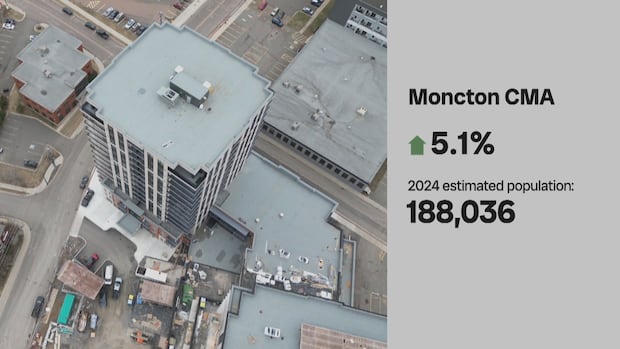Moncton again one of Canada's fastest growing regions, StatsCan estimates
Metro region only behind Calgary for population growth rate
The Moncton region had the second-highest population growth rate of all metro areas across the country, estimates released by Statistics Canada on Thursday show.
The metro area, which includes Dieppe, Riverview and surrounding rural areas, grew 5.1 per cent between July 1, 2023, and July 1, 2024.
Only the Calgary metro area grew faster, at 5.8 per cent, Statistics Canada reported. Moncton outpaced cities like Toronto, Vancouver, Edmonton and the Kitchener–Cambridge–Waterloo area. It was also ahead of the national average of three per cent.
Statistics Canada said international migration continued to be the main source of population growth across Canada.
That was the main factor behind the Moncton region's growth as deaths continued to outpace births.
The region's population grew from 178,599 to 188,036. Of that increase, 7,106 people were immigrants.
David Campbell, an economic development consultant, called the growth in the Moncton region unprecedented.
"You could argue maybe it's too much growth," Campbell said in an interview.
"I think nobody was expecting that level of population growth. But I've always said better the problems of growth than the problems of decline. And the growth numbers in Saint John and Fredericton were pretty impressive, too."
The Saint John region, including Rothesay, Quispamsis, Grand Bay-Westfield and Hampton, grew from 139,095 to 142,433.
The Fredericton region, which includes New Maryland, Hanwell and other rural areas, grew from 118,800 to 122,500.
The figures also include estimates for individual municipalities. The data shows growth in all cities and towns across the province, except Grand Falls and Grand Bay-Westfield.
However, the figures released are based on municipal boundaries in 2021, when the last census was completed, prior to major amalgamations that increased the geographic size of many municipalities.
The City of Moncton, with the largest population in the province, grew from 91,145 to 97,523, an increase of seven per cent.
Saint John grew from 75,263 to 78,165, remaining the province's second-largest city. Fredericton grew from 69,579 to 72,700.
Dieppe, the fourth largest municipality, grew from 32,294 to 34,247. Riverview, the fifth largest, increased from 21,764 to 22,227.
Good news for northern N.B.
In the north, there was also growth in a number of communities:
- Miramichi grew from 18,771 to 19,274.
- Edmundston grew from 17,272 to 17,866.
- Bathurst grew from 12,658 to 13,050.
- Campbellton grew from 7,198 to 7,322.
"This is good news for the province that people are moving not just to the big cities, but also to many of our smaller towns and villages across the province," Campbell said.
The national statistics agency noted data released in December, which covers a more recent time period, shows a slowdown in population growth as the federal government made changes to immigration, work and study permits.
Statistics Canada said Thursday that "it would be reasonable to expect that the high levels of growth seen in urban centres — regions where [non-permanent residents] continue to play a significant role in population growth — would, in turn, slow down when more data become available."
Campbell said migration or immigration help economic growth and tax revenues, which fund public services and help fill jobs in a province with an older workforce.
"So inward population migration, you know, is required if we're going to meet workforce demand in the years ahead," he said.
"So we can have, and we should have, a legitimate discussion about how many people we need to attract and making sure we have the supports and the housing and the services for those folks.
"But to just sort of turn against immigration now at this juncture in our history as a province, I think would be a big mistake."

Moncton Mayor Dawn Arnold told Radio-Canada on Thursday that newcomers are vital for the city's sustainability.
"I guess my argument to the federal government would be that this one-size-fits-all for the entire country has been really challenging.
"Can we accommodate continued growth at this level? Probably not. It probably needs to be tempered somewhat, but it's good for the future of our community."

New Brunswick's minister responsible for immigration and intergovernmental affairs also expressed concern about the federal approach.
"We are just learning of these numbers, but it's not surprising that the changes the federal government is making is having an impact and will continue to slow the momentum the province has gained over the past few years," Jean-Claude D'Amours said in an emailed statement Thursday.
"These numbers are certainly concerning and we call on the federal government to consider New Brunswick's unique situation and needs, and to cease with its one-size-fits all approach."
With files from Radio-Canada


